![News from the Beloved;
after a design by Queverdo [fr] Queverdo Francois-Marie-Isidore - Romanet - Nouvelles du bien-aime.jpg](http://upload.wikimedia.org/wikipedia/commons/thumb/2/28/Queverdo_Fran%C3%A7ois-Marie-Isidore_-_Romanet_-_Nouvelles_du_bien-aim%C3%A9.jpg/250px-Queverdo_Fran%C3%A7ois-Marie-Isidore_-_Romanet_-_Nouvelles_du_bien-aim%C3%A9.jpg)
after a design by Queverdo

after a painting by Matteis
Antoine-Louis Romanet (7 January 1742, Paris - 1 April 1807, Saint-Maurice) was a French engraver, designer, and miniaturist.
![News from the Beloved;
after a design by Queverdo [fr] Queverdo Francois-Marie-Isidore - Romanet - Nouvelles du bien-aime.jpg](http://upload.wikimedia.org/wikipedia/commons/thumb/2/28/Queverdo_Fran%C3%A7ois-Marie-Isidore_-_Romanet_-_Nouvelles_du_bien-aim%C3%A9.jpg/250px-Queverdo_Fran%C3%A7ois-Marie-Isidore_-_Romanet_-_Nouvelles_du_bien-aim%C3%A9.jpg)

Antoine-Louis Romanet (7 January 1742, Paris - 1 April 1807, Saint-Maurice) was a French engraver, designer, and miniaturist.
He was descended from a line of engravers, long established in Paris. One of his cousins was married to the famous engraver, Jean-Georges Wille, who gave him his first lessons. [1] . In 1765, through Wille, he obtained an apprenticeship in Basel with Christian von Mechel, where he learned advanced techniques for using the burin. [2]
In 1767, he left Basel then, in 1770, married Françoise-Nicole née Mancel, the daughter of an innkeeper on the Rue Saint-Jacques, with Wille as witness. [1] They had at least four children; two daughters and two sons.
The police came to his home in 1776, arrested him, and took him to his studio, where they confiscated the copper plates and proofs of an engraving depicting a certain "Mme. de Saint-Vincent". She had filed a complaint in the context of an "affair of morals". The police report also cited his dealer, named "Isabey". [3]
In 1781, he went into business with the art dealer, Jean-Baptiste-Pierre Lebrun, who was himself a painter. At one point, he was forced to sue for payment. [1] He was a regular exhibnitor at the " Salon de la Correspondance" (1779-1787), organized by the writer, Pahin de la Blancherie .
The Swiss miniaturist, Marc-Louis Arlaud, became his student in 1797. Romanet also worked in that genre, but remained almost entirely known for his engravings. [4] During the latter part of his career, his workshop was located at the Place du Pont-Saint-Michel , which disappeared during the creation of the Boulevard Saint-Michel in the 1860s.
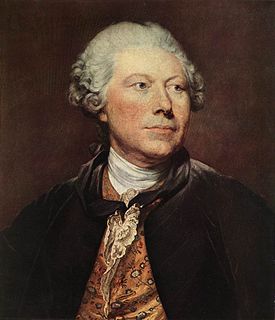
Johann Georg Wille, or Jean Georges Wille was a German-born copper engraver, who spent most of his life in France. He also worked as an art dealer.

Antoine Johannot, known commonly as Tony Johannot, was a French engraver, illustrator and painter.

Louis Pierre Henriquel-Dupont was a French engraver. His students included Charles Bellay, Jean-Baptiste Danguin, Adrien Didier, Alphonse and Jules François, Adolphe-Joseph Huot, Achille and Jules Jaquet, Jules Gabriel Levasseur, Aristide Louis, Louis Marckl, Isidore-Joseph Rousseaux, Abel Mignon and Charles Albert Waltner.

Pierre-François Basan was a French engraver, editor, and print seller.
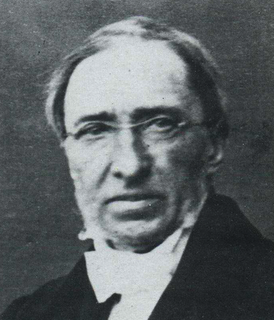
Louis-Henri Brévière was a French engraver. He became known for reviving the art of carving in wood with a burin; which had fallen into neglect since the seventeenth century.

Laurent Cars was a French designer and engraver.

Nicolas-Henri Tardieu, called the "Tardieu the elder", was a prominent French engraver, known for his sensitive reproductions of Antoine Watteau's paintings. He was appointed graveur du roi to King Louis XV of France. His second wife, Marie-Anne Horthemels, came from a family that included engravers and painters. She is known as an engraver in her own right. Nicolas-Henri and Marie-Anne Tardieu had many descendants who were noted artists, most of them engravers.

Jean-Baptiste-Antoine Guillemet was a French renowned landscape painter and longtime Jury member of the Salon des Artistes Francais. He was one of the first 19th-century artists to paint modern life, and a pivotal figure in the transition from Realism to Impressionism.

François Jean-Baptiste Topino-Lebrun was a French painter and revolutionary. He worked in the Neo-Classical style and was said to be the favorite student of Jacques-Louis David.
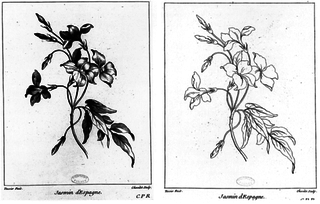
Juste Chevillet (1729–1802) was a French engraver. He is known for his engravings for the Histoire Naturelle of Georges-Louis Leclerc, Comte de Buffon.
Jean-Michel de Venture de Paradis was an 18th-century French orientalist and dragoman.

Louis Michel Halbou was a French draughtsman and engraver of the pre-Romantic period, specialising in burin. His work can be found in several public collections such as the Edmond de Rothschild prints collection in the Louvre, the Musée du château de Versailles et du Trianon, the Art Institute of Chicago and the Wellcome Trust.
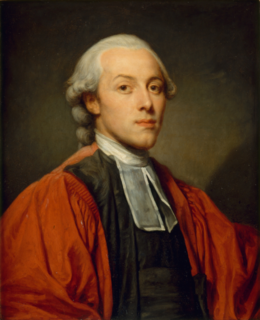
Charles Paul Jean Baptiste de Bourgevin Vialart de Moligny, comte de Saint-Morys was a French art collector.

Actors of the Comédie-Française, also traditionally known as The Coquettes, is an oil on panel painting in the Hermitage Museum, Saint Petersburg, by the French Rococo artist Antoine Watteau (1684–1721). Variously dated within the 1710s by scholars, the painting forms a compact half-length composition that combines portraiture and genre painting, notably influenced by Venetian school, the Le Nain brothers, and Watteau's master Claude Gillot; one of the rarest cases in Watteau's body of work, it shows five figures — two women, two men, and a black boy — amid a darkened background, in contrary to landscapes that are usually found in Watteau's fêtes galantes.
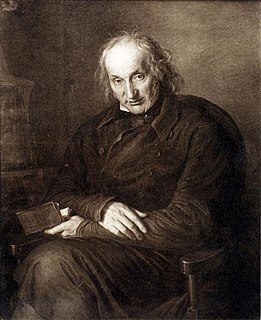
Marc-Louis Arlaud was a Swiss portrait painter. He was the first Director of the Vaudoise Cantonal School of Design and the first Conservator of what is now known as the Cantonal Museum of Fine Arts in Lausanne.

Pierre Lacour, sometimes referred to as "The Younger" was a French painter and engraver.

The Dreamer is an oil on panel painting of c. 1712–1717 in the Art Institute, Chicago, by the French Rococo artist Antoine Watteau. The painting is a single-figure, full-length composition that shows a seated young woman amid a landscape, dressed in somewhat an exotic attire consisting of long red gown with fur garment and white bonnet; it is a recurring subject that is also present in numerous paintings and drawings by Watteau such as The Coquettes, dit Actors of the Comédie-Française. There were attempts to identify the sitter of the painting, who was notably thought to be Watteau's contemporary, the Comédie-Française actress Charlotte Desmares.

Pierre-François Laurent (1739-1809) was an engraver and co-director with Louis-Nicolas-Joseph Robillard de Péronville of the publication Le Musée français. As an engraver, he specialised in landscapes and genre subjects after Dutch artists. He also produced several engravings of subjects from the recent national history.

Gustave Nicolas Bertinot was a French engraver. He was primarily known for his intaglio work.
Nicolas de Poilly, also called Nicolas de Poilly the Younger, Nicolas de Poilly jeune, or Nicolas II de Poilly, was an academically trained French artist who won the Prix de Rome for painting in 1698. Despite an impressive start, he largely abandoned painting for drawing and became an engraver like his father, his uncle François de Poilly, and several others in the Poilly family.
![]() Media related to Antoine-Louis Romanet at Wikimedia Commons
Media related to Antoine-Louis Romanet at Wikimedia Commons